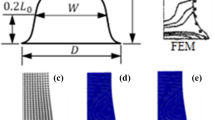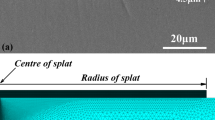Abstract
A simple heuristic model was developed to demonstrate the major characteristics of impinging particles prior to impact and during the spreading stages. It is based on the determination of transfer functions be-tween the powder particle size distribution and splat equivalent diameter distributions. The input data consist mainly of the aforementioned distributions, determined experimentally using a particle size ana-lyzer for powder particle size analysis and the wipe test for splat equivalent diameter analysis. Output data relate to the major characteristics of the impinging particles: flattening degree, intrinsic deposition efficiency, impact velocity, etc. Comparisons of the model predictions with experimental data showed rea-sonable agreement. Implementation of this simple protocol provides understanding of interactions dur-ing the process and also has technological and economical impacts. It permits quality control (QC) of deposition efficiency by control of splat morphologies and aids in the definition of specifications for the powders used (for example, in terms of the lower and upper limits of the particle size distribution leading to the formation of a deposit with given processing parameters) allowing the optimization of the spray pa-rameters to obtain high-integrity deposits.
Similar content being viewed by others
References
G. Chadwick, A System View of Planning, Pergamon Press, 1971, p 390
G. Montavon, S. Sampath, C.C. Berndt, H. Herman, and C. Coddet, Ef- fects of Vacuum Plasma Spray Processing Parameters on Splat Mor- phology, J. Therm. Spray Technol., Vol 1 (No. 4), 1995, p 67–74
G. Montavon, S. Sampath, C.C. Berndt, H. Herman, and C. Coddet, Vacuum Plasma Spray Forming of Astroloy: An Investigation of Processing Parameters, Thermal Spray Industrial Application, C.C. Berndt and S. Sampath, Ed., ASM International, 1994, p 469–475
C.L. Curtis, D.T. Gawne, and M. Priestnall, The Electrical Conductiv- ity of Plasma Sprayed Yttria Stabilized Zirconia, Thermal Spray Coat-ings: Research, Design and Application, C.C. Berndt and T.F. Ber- necki, Ed., ASM International, 1993, p 519–523
L. Bianchi, F. Blein, P. Lucchese, M. Vardelle, A. Vardelle, and P. Fauchais, Effect of Particle Velocity and Substrate Temperature on Alumina and Zirconia Splat Formation, Thermal Spray Industrial Application, C.C. Berndt and S. Sampath, Ed., ASM International, 1994, p 569–574
H.D. Steffens, J. Drozak, and D. Haumann, Morphologie von Sprizteilchen bei verschiedenen Spritzverfahren am Berispiel von Molybdan (Morphology of Thermal Sprayed Particles in Different Spraying Processes Illustrated by the Behavior of Molybdenum), Deut-scher Verlag für Schweiβtechnick DVS-Verlag GmbH, Düsseldorf, Germany, 1993, p 366–370, (in German)
Reference Manual, Tridim, Akilog, Besançon, France, 1994, p 25
T.M. Mayhew and L.M. Cruz Orive, Caveat on the Use of the Delesse Principle of Aeral Analysis for Estimating Component Volume Densi- ties, J. Microsc, Vol 102 (No. 2), 1974, p 195–207
NIH Image 1.59 Reference Manual, National Institutes of Health, 1994
J.C. Russ, The Image Processing Handbook, 2nd ed., CRC Press Inc., 1995, p 674
G. Montavon and C. Coddet, 3-D Profilometries of Vacuum Plasma Sprayed Nickel-Based Alloy Splats Using Scanning Mechanical Mi- croscopy, Thermal Spray Science and Technology, C.C. Berndt and S. Sampath, Ed., ASM International, 1995, p 285–289
S. Fantassi, M. Vardelle, A. Vardelle, and P. Fauchais, Influence of the Velocity of Plasma Sprayed Particles on the Splat Formation, Thermal Spray Coatings: Research, Design and Applications, C.C. Berndt and T.F. Bernecki, Ed., ASM International, 1993, p 1–6
G. Trapaga and J. Szekely, Mathematical Modeling in the Isothermal Impingement of Liquid Droplets in Thermal Spraying, Metall. Trans. B, Vol 22, 1991, p 901–914
J. Madejski, Solidification of Droplets on a Cold Surface, Int. J. Heat Mass Transfer, Vol 19,1976, p 9–20
I. Egry, On the Relation Between Surface Tension and Viscosity for Liquid Metals, Scr. Metall. Mater, Vol 28, 1993, p 1273–1276
J.K. Vennard and R.L. Street, Elementary Fluid Mechanics, 5th ed., John Wiley and Sons Inc., 1976, p 740
X. Chen and E. Pfender, Behavior of Small Particles in a Thermal Plasma Flow, Plasma Chem. Plasma Process., Vol 3 (No.3), 1983, p351–356
X. Chen and E. Pfender, Effect of the Knudsen Effect on the Heat Trans- fer to a Particle Immersed into a Thermal Plasma, Plasma Chem. Plasma Process., Vol 3 (No.2), 1983, p 97–114
P. Fauchais, A. Vardelle, M. Vardelle, J.F. Coudert, and J. Lesinski, Cor- relation of the Physical Properties of Sprayed Ceramic Coatings to the Temperature and Velocity of the Particles Travelling in Atmospheric Plasma Jets: Measurements, Travelling and Comparison, Thin Solid Films, (No. 121), 1984, p 303–316
M. Fukumoto, S. Katoh, and I. Okane, Splat Behavior of Plasma Sprayed Particles on Flat Substrate Surface, Thermal Spraying: Cur- rent Status and Future Trends, A. Ohmori, Ed., High Temperature So- ciety of Japan, Osaka, Japan, 1995, p 353–358
L. Bianchi, P. Lucchese, A. Denoirjean, and P. Fauchais, Zirconia Splat Formation and Resulting Coating Properties, Thermal Spray Science and Technology, C.C. Berndt and S. Sampath, Ed., ASM International, 1995, p 261–266
M.F. Smith, R.A. Neiser, and R.C. Dykhuizen, An Investigation of the Effects of Droplet Impact Angle in Thermal Spray Deposition, Ther- mal Spray Industrial Application, C.C. Berndt and S. Sampath, Ed., ASM International, 1994, p 603–608
H. Liu, E. Miihlberger, A. Sickinger, E.J. Lavernia, and R.H. Rangel, Numerical Investigation of Micro-Pore Formation During Substrate Impact of Molten Droplets in Spraying Processes, Thermal Spray In- dustrial Application, C.C. Berndt and S. Sampath, Ed., ASM Interna- tional, 1994, p 375–380
C. Moreau, P. Gougeon, M. Lamontagne, V. Laçasse, G. Vaudreuil, and P. Cielo, On-Line Control of the Plasma Spraying Process by Monitor-ing the Temperature, Velocity, and Trajectory of In-Flight Particles, Thermal Spray Industrial Application, C.C. Berndt and S. Sampath, Ed., ASM International, 1994, p 431–437
H. Liu, E.J. Lavernia, and R.H. Rangel, Numerical Simulation of the Impingement of Molten Ti, Ni, and W Droplets on a Flat Substrate, J. Therm. Spray Technol., Vol 4 (No.2), 1993, p 369–378
M.F. Smith and R.C. Dykhuizen, Effect of Chamber Pressure on Velocities in Low Pressure Plasma Spray Deposition, Surf. Coat. Technol., (No. 34), 1988, p 25–31
W.R. McPherson, The Relationship Between the Mechanism of Formation, Microstructure and Properties of Plasma-Sprayed Coatings, Thin SolidFilms, (No. 83), 1981, p297–310
Author information
Authors and Affiliations
Rights and permissions
About this article
Cite this article
Montavon, G., Coddet, C., Sampath, S. et al. Quality control of the intrinsic deposition efficiency from the controls of the splat morphologies and the deposit microstructure. J Therm Spray Tech 6, 153–166 (1997). https://doi.org/10.1007/s11666-997-0007-7
Issue Date:
DOI: https://doi.org/10.1007/s11666-997-0007-7




